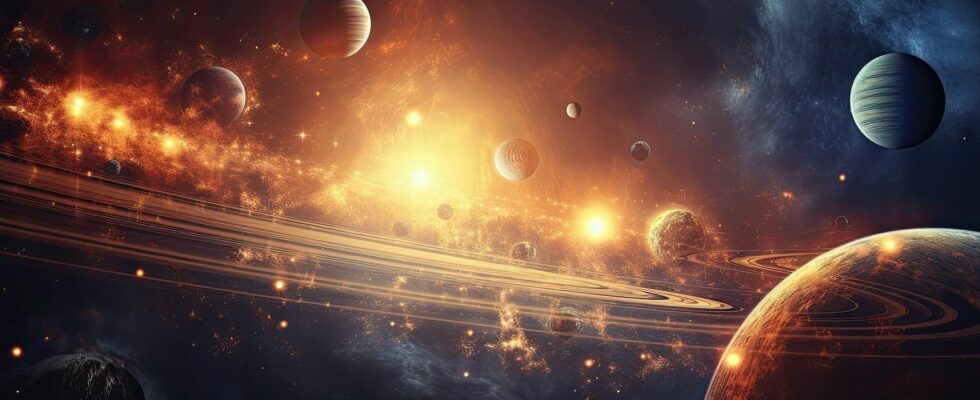According to astrologers, we will have a solar year in 2024. You can find out here what cosmic highlights we can look forward to in the next twelve months.
When is Mercury retrograde? When and where can we see shooting stars? Which new moon covers the sun and when is the full moon? We have picked out a few important astro events of the year for you.
Astro highlights 2024: You can write down these dates
January
Quadrantids: Until January 12th, Earth will be within the influence of the Quadrantids, one of the most active meteor showers in our galactic neighborhood. We reach the peak of the shooting star shower around January 4th.
Mercury: On January 12th we can see the planet in the morning sky, it appears to us just above the horizon like a lost star.
Moon: The new moon in January occurs on the 11th of the month, the full moon is on January 25th.
February
Moon: With the new moon on February 10th, a new lunar year begins and we celebrate Chinese New Year. This lunar year is marked by the Wood Dragon. You can read about the characteristics it represents in our article about Chinese zodiac signs. The full moon will light up our February sky on the 24th.
March
Mercury: On March 24th, Mercury will be visible in the evening sky. At this point the planet is still in direct rotation.
Moon: Sunday, March 10th is the new moon and March 25th is the third full moon of the year. This results in a prenumbral lunar eclipse, i.e. a penumbral eclipse in which the moon is temporarily darkened by the Earth’s shadow. We can observe the lunar eclipse from Europe.
April
Moon: On April 8th, there will be a total solar eclipse as part of the new moon, which can be seen in parts of the USA and Mexico. The full moon falls on the 24th of April.
Mercury: The communication planet is retrograde from April 1st to April 24th.
May
Eta aquariids: The Eta Aquariids are one of the most active meteor showers observed in the Southern Hemisphere. Around the peak on May 8th, 40 to 80 meteors per hour can be expected.
Moon: In May we have a traditional new moon in the zodiac sign Taurus on the 8th of the month, and the full moon occurs on May 23rd.
June
June Bootids: The main season of meteor showers begins in Central Europe in June with the June Bootids. The highest probability of shooting star sightings is on June 27th; we are in the Bootids’ area of influence from June 22nd to July 2nd.
Moon: The new moon is on June 6th and the full moon is on June 22nd.
July
Perseids: In July we reach the area of influence of the Perseids, the most active and reliable meteor shower that we can observe from Central Europe. It starts on July 17th, but the climax doesn’t await us until August.
Moon: A new lunar cycle begins in July with the new moon on the 6th, the halfway point of which is marked by the full moon on July 21st.
August
Peak of the Perseids: Like every year, the Perseids reach their peak on August 12th and 13th. We could now see up to 100 shooting stars per hour, but in reality these are reactions of the Earth’s atmosphere with the debris from Comet Swift Tuttle. The show will be over for this year on August 24th.
Mercury: Mercury is retrograde from August 5th to 28th and moves from the zodiac sign Leo into Virgo during this time.
Moon: In August we have a new moon on the 4th of the month and a full moon on the 19th. The Perseid peak therefore falls in a half-moon period, which is reasonably good for observing shooting stars.
September
Mercury: On September 5th, Mercury can be seen in the morning sky.
Moon: The new moon on September 3rd begins this month’s new lunar cycle, which culminates with the full moon on September 18th. This full moon marks the second lunar eclipse of the year, this time a partial one, in which the Earth blocks part of the moon from sunlight and makes it appear black or cut off. At the same time, this full moon is a supermoon: the lunar disk now appears larger than usual because the moon is particularly close to the Earth.
October
Moon: The lunar eclipse in September is logically followed by a solar eclipse during the new moon on October 2nd. This eclipse is annular or ring-shaped, which means that from our perspective the sun forms a radiant ring around the black disk of the moon. This eclipse can be observed in large parts of South America as well as in southern North America and over the Atlantic. The full moon in October occurs on the 17th of the month and is also considered a supermoon.
November
Moon: November begins with a new moon: On November 1st the moon is between the sun and the earth, and on November 15th this lunar cycle reaches its climax with the full moon.
December
Moon: December also begins on the first of the month with a new lunar cycle, which, like the previous one, culminates on the 15th with the full moon phase.
Mercury: At the end of the year, Mercury can be seen again in the morning sky around December 25th.
Sources used: Spektrum.de, astromedizin.info, starwalk.space, mondrausch.com, timeanddate.com, nationalgeographic.de
